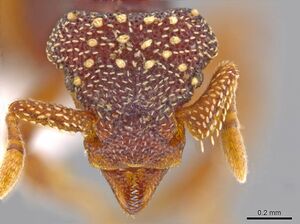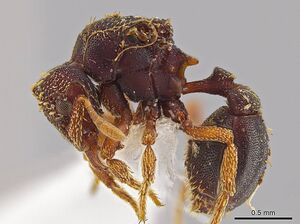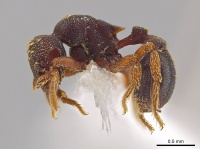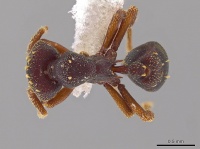Eurhopalothrix zipacna
| Eurhopalothrix zipacna | |
|---|---|

| |
| Scientific classification | |
| Kingdom: | Animalia |
| Phylum: | Arthropoda |
| Class: | Insecta |
| Order: | Hymenoptera |
| Family: | Formicidae |
| Subfamily: | Myrmicinae |
| Tribe: | Attini |
| Genus: | Eurhopalothrix |
| Species: | E. zipacna |
| Binomial name | |
| Eurhopalothrix zipacna Longino, 2013 | |
This species inhabits mature mesophyll cloud forest. It is known from 1290–1430 m elevation. Most specimens are from Winkler samples of sifted litter and rotten wood from the forest floor. One worker was collected at or near a bait on the ground. At the two cloud forest sites where it occurred, it was found in 3–7% of quantitative miniWinkler samples. (Longino 2013)
Identification
Mandible with single tooth row; anterior process of labrum elongate, with deep narrow median cleft, forming pair of closely parallel, long, thin lobes; face with 18 specialized spatulate setae; promesonotum with 3 pairs spatulate setae; HW 0.78–0.85 (Eurhopalothrix bolaui is smaller); base of propodeal spines narrow, abruptly meeting narrow infradental lamella (propodeal spines more broadly triangular in E. bolaui). Similar to E. bolaui. (Longino 2013)
Keys including this Species
Distribution
Latitudinal Distribution Pattern
Latitudinal Range: 18.5333° to 14.9504537°.
| North Temperate |
North Subtropical |
Tropical | South Subtropical |
South Temperate |
- Source: AntMaps
Distribution based on Regional Taxon Lists
Neotropical Region: Guatemala, Honduras (type locality).
Distribution based on AntMaps
Distribution based on AntWeb specimens
Check data from AntWeb
Countries Occupied
| Number of countries occupied by this species based on AntWiki Regional Taxon Lists. In general, fewer countries occupied indicates a narrower range, while more countries indicates a more widespread species. |

|
Estimated Abundance
| Relative abundance based on number of AntMaps records per species (this species within the purple bar). Fewer records (to the left) indicates a less abundant/encountered species while more records (to the right) indicates more abundant/encountered species. |

|
Biology
|
Castes
Worker
Images from AntWeb
   
| |
| Holotype Eurhopalothrix zipacna Longino 2013. Worker. Specimen code casent0617561. Photographer Brendon Boudinot, uploaded by University of Utah. | Owned by CAS. |
Queen
Images from AntWeb
  
| |
| Queen (alate/dealate). Specimen code casent0612531. Photographer Brendon Boudinot, uploaded by University of Utah. | Owned by JTLC. |
Nomenclature
The following information is derived from Barry Bolton's Online Catalogue of the Ants of the World.
- zipacna. Eurhopalothrix zipacna Longino, 2013: 146, figs. 12B, 34, 35 (w.q.) HONDURAS.
Unless otherwise noted the text for the remainder of this section is reported from the publication that includes the original description.
Description
Worker
HW 0.78–0.85, HL 0.72–0.78, SL 0.43–0.45, SLL 0.04–0.05, CI 107–110, SLI 10–11 (n=2). Labrum with anterolateral gibbosities of basal portion developed as sharply right-angled, ventrally-directed teeth, apical portion elongate, flexed dorsally, relatively narrow, with a deep, narrow cleft, forming pair of closely parallel, long, thin lobes (similar to E. bolaui, but with more elongate lobes); apex with a fringe of short, non-capitate translucent setae; mandible triangular, dorsal surface convex, punctate on basal half, smooth and shining apically, rounding into ventral surface; interior surface concave, smooth and shining; masticatory margin a single row of 11 flattened acute triangular teeth; scape with weakly developed basal lobe; scrobe deep, sharply delimited dorsally and ventrally, abutting deep antennal socket; surface of scrobe faintly foveolate; eye small, about 6 ommatidia across greatest diameter; clypeus approximately planar, uniformly punctate, dull; sides of head above eyes angulate; surface of face uniformly convex, punctate, puncta smaller anteriorly; occipital carina indistinct; undersurface of head uniformly punctate; postgenal suture a well-developed longitudinal trough.
Promesonotal profile with pronotum rounding into somewhat flat-topped mesonotum; mesonotum and dorsal face of propodeum almost in same plane, with only slight drop; metanotal groove not impressed; dorsal and posterior faces of propodeum distinct, meeting at obtuse angle, dorsal face subequal in length to posterior face; propodeal spine laminar, translucent, triangular, acute, ventral margin rounding into narrow infradental lamella that extends down posterior face to propodeal lobe; propodeal spiracle small, directed posteriorly in small concavity between base of propodeal spine and dorsum of metapleural gland bulla; all of mesosoma except posterior face of propodeum punctate; posterior face of propodeum with puncta extending part way down, grading to smooth and matte; no transverse carinae between bases of propodeal spines; puncta on promesonotum larger than those on katepisternum and side of propodeum.
Petiolar peduncle joins anterior face of petiolar node at rounded obtuse angle; anterior face of node meets sloping flat dorsal face at rounded right angle; posterior face of node very short; ventral margin of petiole with short, acute, anteroventral tooth; postpetiole low and broad, with a broad longitudinal sulcus dorsally; first gastral sternite lacking anterior sagittal keel; petiole, postpetiole, first gastral tergite covered with dense, nearly confluent puncta; first gastral sternite similar, but puncta and interspaces larger.
Dorsal surface of scape covered with uniform short, decumbent, flattened setae; leading edge of scape with projecting narrowly spatulate setae, strongly curved, except seta on basal lobe, which is longer and straight; ground pilosity on clypeus sparse, narrow, fully appressed; ground pilosity of face similar in size and shape to ground setae on dorsal scape, appressed, sparse, separated from each other by distance greater than or equal to length, more or less uniformly distributed across entire face, including frontal lobes; projecting specialized setae strongly spatulate, pompon-like, erect and highly differentiated from ground pilosity, full complement 18, with curved anterior row of 8, transverse median row of 4, and posterior row of 6 on vertex margin; ground pilosity very sparse to nearly obsolete on dorsal mesosoma, denser on dorsa of petiolar node and postpetiole; 3 pairs projecting spatulate setae on promesonotum; legs with ground pilosity denser and more flattened than that on face, dense on apices of femora, dorsal and anterior faces of mid and hind tibia, dorsal and posterior face of foretibia, sparser to absent elsewhere; apices of tibiae with 1 larger spatulate seta; basitarsus with 3–5 pairs suberect spatulate setae, remaining tarsomeres each with pair of suberect clavate setae, tarsal setae smaller on foretarsus than on mid and hind tarsus; two large spatulate setae on hind margin of dorsal face of petiolar node; row of 4 spatulate setae on hind margin of postpetiole, median pair smaller than lateral pair; first gastral tergite with very sparse, very thin, fully appressed ground pilosity; specialized setae of first gastral tergite spatulate, full complement 3 pairs in two longitudinal rows.
Color dark brown.
Queen
HW 0.86, HL 0.79, SL 0.48, SLL 0.06, CI 108, SLI 12 (n=1). Similar to worker in most respects; ocelli present; compound eye much larger than worker eye; anepisternum separated from katepisternum by U-shaped groove; metapleuron separated from propodeum by broad U-shaped groove; anepisternum and katepisternum both with anterior half smooth, matte grading to shiny; face with number and distribution of setae like worker; pronotum with 1 pair spatulate setae; mesoscutum with 4 linear setae; axilla with 1 clavate seta; scutellum with 1 pair spatulate setae; first gastral tergite with number and arrangement similar to worker, but setae longer, clavate rather than spatulate.
Type Material
Holotype worker: Honduras, Cortés: PN Cusuco, 15.48940 -88.23598, ± 20 m, 1290 m, 30 May 2010, mesophyll forest, ex sifted leaf litter (LLAMA Wa-C-06-2-07) California Academy of Sciences, unique specimen identifier CASENT0617561]. Paratype workers, queen: same data as holotype but 15.48896 -88.23439 (LLAMA Wm-C- 06-1-01) CASC, CASENT0639406 (dealate queen); National Museum of Natural History, CASENT0639407; Museum of Comparative Zoology, CASENT0639408; same data but 15.48683 -88.23422, ± 300 m, 1340 m (LLAMA Wm-C-06-1-02) Museu de Zoologia da Universidade de Sao Paulo, CASENT0639409.
Etymology
Zipacna was the Mayan demonic personification of the earth's crust. It is a noun in apposition and thus invariant.
References
- Longino J. T. 2013. A review of the Central American and Caribbean species of the ant genus Eurhopalothrix Brown and Kempf, 1961 (Hymenoptera, Formicidae), with a key to New World species. Zootaxa 3693: 101-151 (doi:10.11646/zootaxa.3693.2.1).
- Wetterer, J.K., Booher, D.B. 2023. Geographic distribution of Eurhopalothrix floridana (Hymenoptera: Formicidae). Transactions of the American Entomological Society, 149(3), 315-324 (doi:10.3157/061.149.0303).
References based on Global Ant Biodiversity Informatics
- Dattilo W. et al. 2019. MEXICO ANTS: incidence and abundance along the Nearctic-Neotropical interface. Ecology https://doi.org/10.1002/ecy.2944
- Longino J. T. 2013. A review of the Central American and Caribbean species of the ant genus Eurhopalothrix Brown and Kempf, 1961 (Hymenoptera, Formicidae), with a key to New World species. Zootaxa 3693(2): 101-151.
- Longino J. T. L., and M. G. Branstetter. 2018. The truncated bell: an enigmatic but pervasive elevational diversity pattern in Middle American ants. Ecography 41: 1-12.
- Longino J. et al. ADMAC project. Accessed on March 24th 2017 at https://sites.google.com/site/admacsite/


